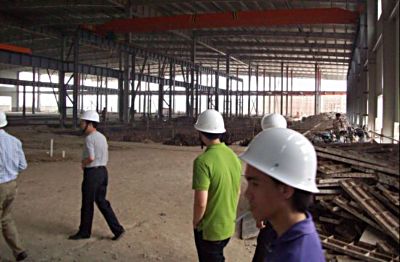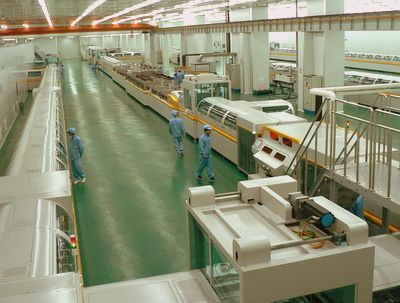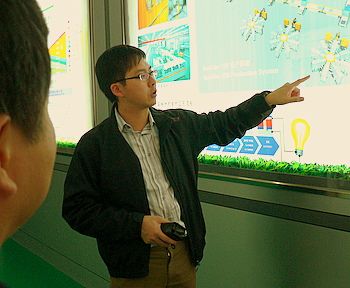
INVESTORS WARMED up to the long-awaited news yesterday from Anwell Technologies that it had begun mass production of amorphous silicon (“a-Si”) thin film solar panels.
The news was released at 7.15 am, triggering a rise in the shares of Anwell, which are listed on the Singapore Exchange, when trading began at 9 am.
By the end of the day, the stock closed at 57 cents, or 3.5 cents higher (or 6.5%) than the previous trading day’s close.
About 1.62 million shares changed hands yesterday, significantly higher than the 210,000 daily average during the past three trading days.

In the space of two short years, Anwell has developed its proprietary production line and started mass production.
Only three other companies in the world have the capability to develop solar panel production lines: Applied Materials (US), Oerlikon (Switzerland) and Ulvac (Japan). However, all these three do not manufacture solar panels.
”Our unique vertically integrated business model, where we produce both the production line and thin film solar panels, gives us a distinct advantage in terms of cost and quality control over our competitors,” said Franky Fan, Executive Chairman & CEO of Anwell.

Anwell, which is headquartered in Hong Kong, appears to have bet on the ‘right’ type of solar panels to produce in its factory in Henan, China.
Thin film panels deliver a lower cost per watt compared to conventional crystalline silicon panels.
The latter are of mature technology and is losing market share to thin-film technology which is superior technologically and has wider applications.
Thin film solar panels made up 19.8% of globally produced solar panels in 2009, up from a 12.8% market share in 2008.
This growth trend is expected to continue into 2010, where thin film solar panels are forecast to make up to 23.4% of the 12.1GW worth of total production, according to Displaybank, a global market research and consulting company.
Anwell is targeting the European market where there is strong governmental push for solar installations. Europe heavily relies on imports, leading Anwell to “believe it is an ideal market for us to sell our solar panels,” said Mr Fan.
”The German distribution centre we set up in late 2009, has already paved the way for this growth.The marketing contacts and channels established over the last few months will allow us toimmediately partake in this huge demand for solar panels in Europe market.”
A unique aspect of Anwell’s equipment is that it allows for the upgrading of its existing capabilities without purchasing a separate new line, representing substantial cost savings as it plans to increase its capacity to 120MW by the end of 2010.
In a telephone interview from his office in Hong Kong yesteday afternoon, Anwell CFO Ken Wu spoke with the Singapore media. Highlights:

Q Where will the solar panels sold and what is the potential for sales?
Mr Wu: We have sales staff in Europe and US. The best panel market in Europe is Germany. For our thin-film panels, we have not received orders yet because customers would like to see samples first.
Starting in Q4 last year, we have a distribution center in Germany to sell some solar products purchased from suppliers in China and we distribute them in Germany. So we don’t really worry about the sales side. At the moment, we want to focus on the technical side of our production.
Q When do you expect to deliver the first batch of your thin-film panels?
Mr Wu: We expect that to be in May or June.
Q What capacity are your machines running at?
Mr Wu: The installed capacity is 40 MW. We are running at 30% of the full capacity - we turn the machines relatively slower to make sure all the production process and material and quality are fine.
Q Are the other three global players who develop production lines also in the business of mass producing solar panels?
Mr Wu: They only sell the equipment. Anwell has a unique vertically integrated model. That’s why we have a key advantage in cost and in technology as we can acquire the latest technology.
Q Given those advantages, will you sell panels at market prices or below market?
Mr Wu: Products like solar panels are commodities and there is a market price out there. So we will sell at market prices.
Q What is the expected revenue from the mass-produced solar panels?
Mr Wu: We would see a much bigger improvement in our solar panel revenue from Q3. Starting from next year, I would expect our solar panel business to represent over 50% of our full-year revenue.
Q How much was the investment in the Henan solar plant?
Mr Wu: Including the equipment and the plant, we have invested US$40 million.
Q To increase to 120 MW by the end of this year, would you need three times as much money?
Mr Wu: It would be significantly less than that as we have invested already in the property, plant and utilities. Sorry, I can’t disclose the figure. Our equipment was designed in a very smart way which can be upgraded to 120MW.
Q What is the near-term plan for the solar business?
Mr Wu: We plan to increase the capacity to 360 MW in three years' time, and then spin off the solar business as a separate listed company possibly in the US or in China. The US market traditionally provides a better valuation for renewable energy businesses. As for China, it is an up and coming stock market that is growing quickly. After the spinoff, our Singapore-listed company would be a holding company holding another listco in US or China.
Q Is this spin off for raising funds?
Mr Wu: The most important purpose is to generate value for our shareholders. It could also be a way to raise funds.
Recent story: ANWELL: Lively Q&A with fund managers







